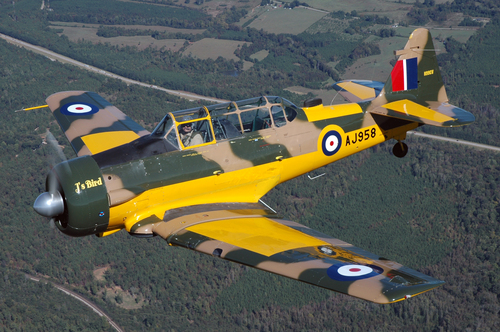J's Bird is a 1952 Canadian Car and Foundry Harvard Mk 4.
J's Bird was received by the Royal Canadian Air Force (RCAF) on 9 September 1952 and served with No. 1 Flying Instructor's School at RCAF Station Trenton, Ontario. The aircraft was stuck from the records on 15 August 1966. It also spent some time with the Canadian Warplane Heritage, a flying museum similar to the American Airpower Heritage in this country, based in Ontario, Canada. After that it ended up in Vancouver, British Columbia where it was used in an aerial combat operation; "fighter pilot for a day" if you will.
The paint scheme represents that applied to training and administrative aircraft in Britain during World War II. The serial number you see actually belongs to a Harvard Mk II that saw service in England during that period. In that sense it is completely accurate, or inaccurate, depending on your point of view.
The model was first ordered by the British Empire in 1938 and should not be confused with the Wirraway or Yale, which are part of the same family. Once North American Aviation produced a successful airframe, the US military caught on and purchased the aircraft as the T-6 Texan for the Air Corps and the SNJ for the US Navy. Production stopped for good in 1954 with 15,649 Texans and Harvards produced.
There are about 600 left flying today throughout the world. The numbers are sometimes debated, as production lapsed at war's end and, in the US, airframes were ran back through the assembly line to produce the T-6G/SNJ-6. Canada used new-old stock and new production stock to produce the Harvard Mk 4.
Whichever model it may be, it's powered by Pratt & Whitney R-1340-AN1, nine-cylinder radial engine producing 600 hp at takeoff. US models had a short stack exiting the cowl's right side while the Canadians added about 7 feet to that and inserted an intensifier tube for the cabin heater, understandable given Canadian winters. British Spotting Manuals mention the sound of the Harvard as an identifying feature, claiming it sounded like a noisy two-stroke motorcycle. During World War II, it trained almost all Allied pilots, and in some variants trained aerial gunners with a swivel gun mounted in the rear cockpit. At one time or another, most countries of the world including some old enemies have used this airframe. In the post WWII period the airframe was also employed in a ground attack role by many countries and saw service with the USAF as a Mosquito, the LT-6, doing FAC (forward air controller) work in Korea.
Manufacturer: Canadian Car and Foundry (under license from North American Aviation). Wing Span: 42 feet, 4 inches. Length: 27 feet, 11 inches. Maximum Gross Weight: Approximately 5700 pounds. Engine: One (1) Pratt & Whitney R-1340-AN-1. Horsepower: 600 rated at TO (36 inches of Manifold Pressure/ 2250 RPM). Cruise Speed: 135 Knots at 27 inches MP/1750 RPM/27 gph (at least that's what I get)

